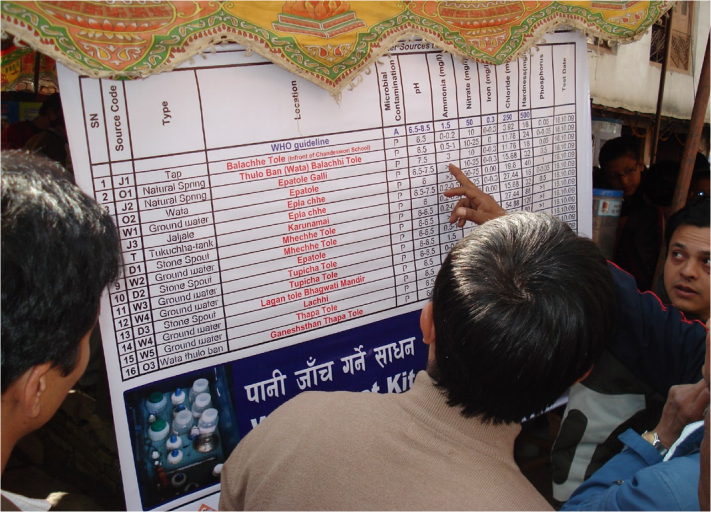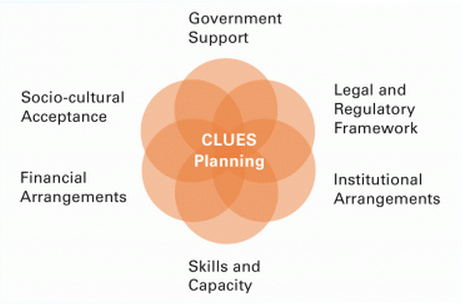CLUES Approach

Not to be confused with community-led total sanitation, the Community-Led Urban Environmental Sanitation (CLUES) approach presents comprehensive guidelines for the planning and implementation of environmental sanitation infrastructure and services in disenfranchised urban and peri-urban communities. The planning approach builds on a framework, which balances the needs of people with those of the environment to support human dignity and a healthy life. CLUES is a multi-sector and multi-actor approach for the planning and implementation of water supply, sanitation, solid waste management and storm drainage. It emphasises the participation of all stakeholders from an early stage in the planning process.
CLUES is a further development of the Household-Centred Environmental Sanitation (HCES) planning approach, which is based on the Bellagio principles for sustainable sanitation. HCES was conceived by the Environmental Sanitation Working Group of the Water Supply and Sanitation Collaborative Council (WSSCC). Intensive piloting and evaluation of the HCES approach took place between 2006 and 2010 in Africa, Asia and Latin America, in seven different urban and peri-urban sites. The experiences and lessons learned from these pilot projects were used to develop a revised and simplified set of planning guidelines. The name change from HCES to CLUES highlights the importance of broad community involvement (beyond the household level) in the planning and decision-making process.
In a CLUES process, the most sustainable solutions are identified through the involvement and mobilisation of all stakeholders, particularly the targeted community, and by taking into account the complex realities, priorities and available resources on the ground. CLUES planning includes the development of a timed and output-based action plan which is implementable by the community, the local authority and the private sector, and elaborates management strategies for operation and maintenance of the solutions put in place. The CLUES approach includes three distinct elements: 7 planning steps, 3 cross-cutting tasks relevant throughout the entire planning process, and the enabling environment which is required for sustainable interventions.
| Advantages | Disadvantages |
|---|---|
| - CLUES follows a realistic, structured and field-tested step-by-step procedure - Community mobilisation and contributions: CLUES promotes the participation of the residents in the planning process steps (e.g. consultation meetings) |
- People-centred planning takes time, more so than conventional expert-led planning approaches - Low-income communities are not always capable of self-financing the planning and implementation of improved environmental sanitation services |
The 7 Planning Steps



Step 1: Process Ignition and Demand Creation
The planning process begins with ignition and promotional activities. This step aims at sensitising the community to environmental sanitation and hygiene issues and to create momentum and a solid platform for community participation. After a participative community mapping exercise and the discussion of key concerns with the residents in a first community meeting, an agreement on action is formulated and a community task force is formed by previously identified community champions.
Step 2: Launch of the Planning Process
In step 2 all key stakeholders formally come together to develop a common understanding of the environmental sanitation problems in the intervention area and agree on the process of how to address them. The launching workshop must be inclusive, well-structured and attract public attention. In step 2 stakeholders generate a protocol agreement, an agreement on the project boundaries and an agreement on the overall planning methodology and process.
Step 3: Detailed Assessment of the Current Situation
In step 3 stakeholders compile information about the physical and socio-economic environment of the intervention area. This step is important because it provides necessary background information for all future planning steps. Outputs include a refined stakeholder analysis, baseline data, and a thorough assessment of the enabling environment and current levels of service provision. The main outcome of step 3 is a detailed status assessment report for the intervention area.
Step 4: Prioritisation of the Community Problems and Validation
In step 4 stakeholders deliberate the findings and implications of the assessment report, and identify and prioritise the leading general and environmental sanitation problems in the community. The main outcomes of step 4 are the validated assessment report and an agreed-upon list of priority problems in the community.
Step 5: Identification of Service Options
In step 5 the planning team, in consultation with environmental sanitation experts and key stakeholders, uses an informed choice approach to identify one or two environmental sanitation system options that are feasible for the intervention area and can be studied in greater detail. The community and the local authorities reach agreement based on an understanding of the management and financial implications of the selected systems.
Step 6: Development of an Action Plan
In step 6 stakeholders develop local area action plans for the implementation of the environmental sanitation options selected in step 5. The action plans must be implementable by the community; the local authorities and the private sector (see also public private partnerships). The main output of step 6 is a funded action plan that follows time sensitive, output-based targets. Every action plan must contain an operation and maintenance management plan to ensure the correct functioning of the sanitation system.
Step 7: Implementation of the Action Plan
As the goal of step 7 is to implement the CLUES action plan developed in step 6, this last step strictly speaking is not part of the planning process. Stakeholders translate the action plan into work packages, which ultimately become contracts for implementing the service improvements. The final stage of step 7 is the implementation of the operation and maintenance management plan.
Who should be involved in the launch of the planning process?
The official launch of the process should be held after the community meeting of step 1 in the form of a multi-stakeholder workshop. An expert facilitator should moderate the workshop. It should be attended by the various stakeholders identified during the kick-off events and should include the process leader, municipal health officers, municipal and district authorities, utility representatives, NGOs, university lecturers and students and representatives from the community, including the project coordination committee.
Cross-cutting Tasks
There are 3 cross-cutting tasks which are relevant throughout the entire planning process:
- Awareness raising and communication are key to creating demand and raising people’s abilities to make informed choices about the most appropriate systems and technologies.
- Capacity development aims at strengthening process management and collaborative planning skills as well as engineering, construction, operation and maintenance skills.
- Process monitoring and evaluation allows the identification and correction of mistakes or imbalances and the changing of shape and direction of the project before it is too late.
The Six Elements of the Enabling Environment

In order for a CLUES process to be successful, it has to take place in a so-called enabling environment. An enabling environment can be seen as the set of interrelated conditions that impact on the potential to bring about sustained and effective change. This includes political, legal, institutional, financial and economic, educational, technical and social conditions, which encourage and support certain activities. An enabling environment is important for the success of any development investment; without it, the resources committed to bringing about change will be ineffective.
The six elements that define an enabling environment need to be nurtured and pro-actively fostered to provide favourable conditions for planning in challenging urban environments. CLUES includes a framework for the identification and assessment of critical elements and explains how they can be addressed and developed to support an enabling environment and facilitate the progress.
Most of the critical elements to support an enabling environment should be identified or become evident during the planning process. Ideally, these elements should be identified, at least in broad terms, prior to starting the planning and consultative process (step 2 in the 7-step programme), so that the entire process does not start off with unrealistic expectations or misconceptions.
| To continue reading check out the complete guide, Community-Led Urban Environmental Sanitation (CLUES), which includes a list of related links and case studies on the SSWM website. |
Acknowledgements
- Arne Menn and Lukas Ulrich, Community-Led Urban Environmental Sanitation (CLUES). Sustainable Sanitation and Water Management.
- Christoph Lüthi, Antoine Morel, Elizabeth Tilley, and Lukas Ulrich. Community-Led Urban Environmental Sanitation Planning: CLUES - Complete Guidelines for Decision-Makers with 30 Tools. eawag and UN-Habitat.